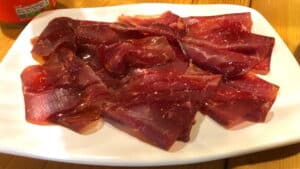
The Camino de Santiago is not only a historical and spiritual journey, but it can also be considered a gastronomic expedition. Along its various routes, the pilgrim encounters genuine culinary treasures with Protected Designation of Origin (PDO) or Protected Geographical Indication (PGI).
These high-quality local products — wines, cheeses, cured meats, etc. — can be enjoyed and purchased without having to deviate from the itinerary. In each region, the same route offers unique flavours directly along the way, from traditional markets to farms, wineries, and local festivals.
Proper planning helps ensure you don’t miss these delicacies (and for this many pilgrims rely on the help of Santiago Camino agencies specialising in the route). Below, we explore the most iconic origin-labelled products along all the Camino de Santiago routes, with their points of interest, so that your pilgrimage is also a journey of flavours.
Índice de contenidos
- 1 French Way: wines, orchards and world-famous cheeses
- 2 Camino del Norte: Cantabrian flavours between sea and mountains
- 3 Camino Primitivo: artisan tradition in the Astur-Galician mountains
- 4 Camino Portugués: coast and interior with wines and Atlantic seafood
- 5 Camino Sanabrés
- 6 Other routes: from Galicia to the table
French Way: wines, orchards and world-famous cheeses
The French Way passes through some of Spain’s richest gastronomic regions, offering numerous PDO products within the reach of the pilgrim.
Navarre
In Navarre, as soon as you start walking from Roncesvalles or Pamplona, you can taste the famous Navarre Asparagus, protected since 1986 and recognised as a PGI for its tenderness and flavour.
Near Estella is the town of Lodosa, famous for its Piquillo Peppers. These sweet red peppers, roasted and peeled by hand, have a protected designation of origin and are a hallmark of the Estella region.
Another must-see is the Wine Fountain of Irache Winery, in Ayegui: a fountain next to the monastery where pilgrims can serve themselves free PDO Navarra wine, a tradition that has now become a part of the pilgrimage. Nothing better to taste the local culture than a sip of Navarra wine during your stage.
La Rioja
La Rioja is world-renowned for its wines. During the stage leading to Logroño, the vineyards of the D.O.Ca. Rioja accompany the pilgrim between Navarrete and the capital of La Rioja. Rioja wine is one of the most prestigious in Spain and can be found in several wineries and taverns along the Camino.
In addition to wine, the region offers other certified products like Riojan Chorizo, a sausage with Protected Geographical Indication since 1990. Tasting it with bread at a village market is a typical experience that pilgrims can enjoy without deviating from the route.
Also from this region are the Rincón de Soto Pears, the first Spanish fresh fruit with PDO (recognised in 2002), highly appreciated for their sweetness. If you pass through Nájera or Santo Domingo de la Calzada during the season, look for them in local greengrocers.
Castilla León
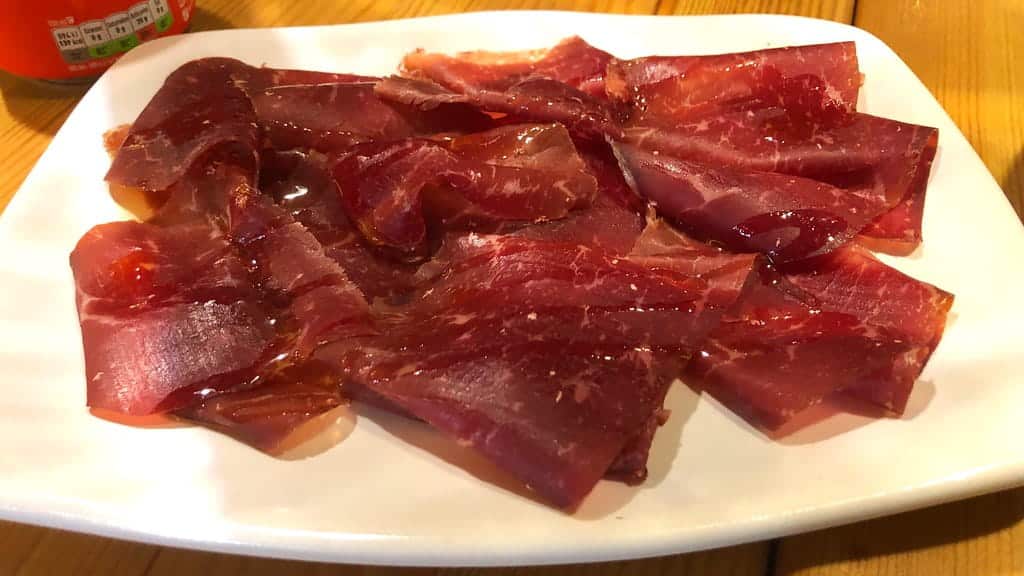
In Burgos lands, you must try the famous Burgos Black Pudding (although it does not have PDO, it is a local and almost national emblem) and the wines from the Ribera del Duero PDO, in the Aranda and Burgos areas.
Further along, in the province of León, the star product is Cecina de León, cured and smoked beef with its own PGI since 1994 (a true Leonese delicacy). Many Camino restaurants offer local sausages on the pilgrim’s menu, so you can try cecina without deviating, for example, in Astorga or Ponferrada.
In the Bierzo region (Ponferrada, Villafranca), in addition to the D.O. Bierzo wine made mainly from Mencía grapes, there is the Botillo from Bierzo (smoked sausage made from pork ribs, with PGI). The pilgrim crossing these localities in winter may encounter a hot plate of botillo at a local festival.
Galicia
Finally, upon entering Galicia through O Cebreiro, the French Way delights with unique cheeses and dairy products. In the same village and its surroundings, the O Cebreiro Cheese is made, a white, fresh cheese with its own PDO, soft in texture and shaped like a fungus (mushroom). This traditional product, tied to the monasteries that served pilgrims since the 9th century, received its PDO in 2004.
The region also produces Galician Veal (PDO), beef from native breeds that appears in many pilgrim menus. And we cannot forget the famous Octopus á feira in Melide (although it does not have PDO, it is a gastronomic landmark on the Camino).
Before reaching Santiago, in Arzúa, many pilgrims try the Arzúa-Ulloa Cheese PDO, creamy and soft, typical of that town. And after arrival, nothing better than celebrating with an Original Tarta de Santiago (this famous almond cake has Protected Geographical Indication, guaranteeing its traditional production in Galicia).
Camino del Norte: Cantabrian flavours between sea and mountains
The Camino del Norte, which runs along the Cantabrian coast from Irún to Santiago, offers pilgrims a mix of marine and mountain gastronomy, with many certified products.
Basque Country
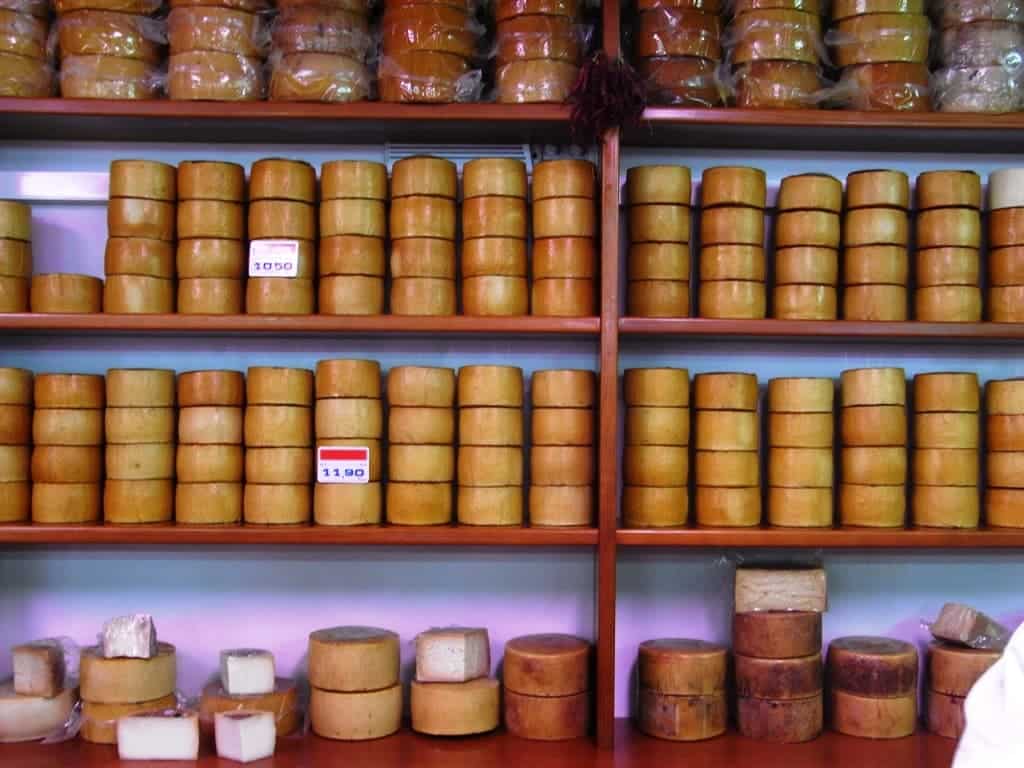
In the Basque Country, at the start of the route, one can taste the Idiazábal Cheese PDO, a typical sheep cheese from the Basque Country and Navarra, available in cider houses and shops in San Sebastián or Guernica.
Also, white winesTxakoli (such as the one from Getaria, with D.O. Getariako Txakolina) brighten the journey with their freshness, for example, accompanying a pintxo in Zarautz or Bilbao.
Cantabria
Following the coast towards Cantabria, a must-stop is Santoña, famous for its anchovies in brine. The Anchoas de Santoña (Cantabrian bocarte) are in the process of obtaining PGI status due to their recognised quality, and many pilgrims take the boat ride from Laredo to Santoña to buy jars of anchovies directly from the factory or the local market.
In this region, there are many artisan cheeses with PDO. For example, the Quesucos de Liébana PDO. These are made inland but can be found for sale in coastal towns along the Camino (small mixed cheeses made from cow, goat, and sheep milk, some smoked, protected by PDO since 1994).
Following the Camino de Santiago Santander Gijón, the pilgrim cannot miss tasting the Cantabria Cream Cheese PDO, a buttery variant of cow’s milk, very common in breakfasts and cheese boards in Santander, Santillana del Mar, or Comillas. It has been protected since 1985 and is a regional emblem.
Other Cantabrian products accompany the Camino: sobaos pasiegos and quesada (typical sweets from the Pasiegos Valleys) can be found everywhere, even though they don’t have a Protected Geographical Indication (PGI), and they are ideal for replenishing energy. Additionally, Cantabria offers miel de Liébana and orujos de Potes with a quality seal, which can be purchased at local stalls when the interior Camino connects with these areas.
Asturias
Upon entering Asturias, the route also becomes one of cheese and cider.
Here, the famous Cabrales Cheese D.O.P. stands out, perhaps the most famous blue cheese in Spain. It is cured in natural caves in the Picos de Europa and has been protected since 1981. Although the village is not on the Camino, it’s easy to find portions in almost any Asturian restaurant. A very pilgrim-friendly plan is to order a serving of cabrales cheese with cider in a chigre (cider house) after the day’s walk.
Similarly, the Gamonéu Cheese D.O.P. (another blue variant) and the Afuega’l Pitu D.O.P. are part of the local cheese heritage. The latter, with a curious name that means “strangle the chicken” in Asturian, is a soft cow’s cheese, traditional from the central valleys of Asturias (Grado, Salas, Tineo), areas that the Camino Primitivo passes through. It has had D.O.P. status since 2008 and is still made on family farms.
Of course, it is impossible to talk about Asturias without mentioning Sidra de Asturias D.O.P.. Asturian cider makers produce this apple drink which received the protected designation in 2003.
In practically every town in Asturias, you will find cider houses where local natural cider is poured. Villaviciosa, a stop on the Camino del Norte, is the capital of Asturian cider: there are cider houses (llagares) where pilgrims can visit, and even museums dedicated to this drink, all without straying from the official route.
For pilgrims, cider is not just a drink, but an entire experience: they will see the peculiar method of serving it from above and can toast with the locals. Thanks to the D.O.P., we know that all cider labeled as such is made 100% from Asturian apples of native varieties. To accompany the cider, nothing better than tortos de maíz or a bollu preñao (bread stuffed with chorizo).
Galicia
We revisit the region, but now highlight other products. Upon reaching Santiago via the northern route, just like with any other route, the pilgrim can celebrate with a good Albariño D.O. Rías Baixas. Although the Rías Baixas vineyards are further south, many Compostela enotecas offer bottles of Albariño to take as a souvenir or to taste after reaching the goal.
In summary, the Camino del Norte delights with Cantabrian fish and seafood (hake, bonito, Santurce sardines, etc.), mountain sausages, and meadow cheeses. All of this is within reach of the walker in coastal inns, cider houses, and local gastronomic festivals.
Camino Primitivo: artisan tradition in the Astur-Galician mountains
The Camino Primitivo shares many products with the Northern route (after all, it runs through Asturias and Galicia). However, it has its own special gastronomic stops in the rural areas it passes through.
Asturias
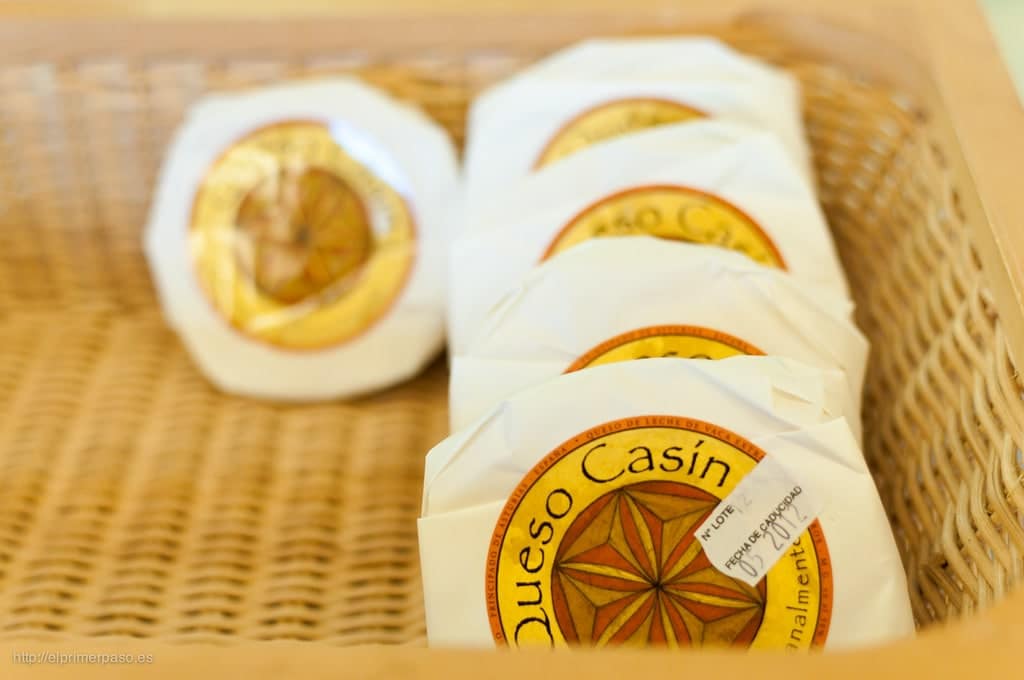
In addition to the ones mentioned, another standout cheese is Queso Casín D.O.P., one of the oldest cheeses in Asturias, made in Caso and Sobrescobio (in the central-southern Asturian mountains). Although the Camino Primitivo does not pass through these valleys, it is often found in stores in Oviedo and Pola de Allande.
Besides dairy products, here the pilgrim can discover Asturian mountain honey (many beehives in the Tineo and Grandas de Salime area produce Miel de Asturias IGP, made from heather or eucalyptus, and jars are often sold in small rural shops along the Camino).
Galicia
Upon entering Galicia, in the region of A Fonsagrada, one of the most unique products is the butelo (similar to the berciano botillo, a sausage made from pork ribs), typical of this area and with a gastronomic festival in February.
And of course, Galicia gifts us with the San Simón da Costa Cheese D.O.P.: This smoked cow’s milk cheese is native to the Terra Chá region in Lugo, near the route. In fact, in Melide, where the Primitivo joins the Francés, they usually offer San Simón cheeses alongside those from Arzúa at fairs.
A cultural and gastronomic point of interest on the Camino Primitivo is the Monastery of San Julián de Samos (Lugo). Here, the Benedictine monks of Samos produce herbal liqueurs and pomace brandy in an artisanal manner, as well as honey, which they sell to pilgrims who visit the monastery. Although these liqueurs do not have D.O.P. status, they are part of the local heritage and their recipe has been passed down through generations.
Camino Portugués: coast and interior with wines and Atlantic seafood
The Portuguese Way, both on its central route from Tui and on the coastal variant from Oporto, is full of Atlantic flavours.
Portugal

If you start in the neighbouring country, you will be able to enjoy a good Vinho Verde D.O.C. produced in northern Portugal (Minho) from day one. The coastal route from the city of Porto passes through wine-growing areas such as Viana do Castelo and the Minho Valley, known for their young and fruity white wines. In fact, many pilgrims take the opportunity to begin the Camino de Santiago from Porto to A Guarda before setting off.
Although it is not actually produced on the coast (it comes from the interior of the Douro), the city offers multiple winery-museums where you can stamp your credential with a toast.
Heading north, we pass through Portuguese fishing villages where fish markets are abundant: Matosinhos (in Porto) is famous for its market and grilled sardines, an Atlantic product that is essential in the local diet.
Galicia
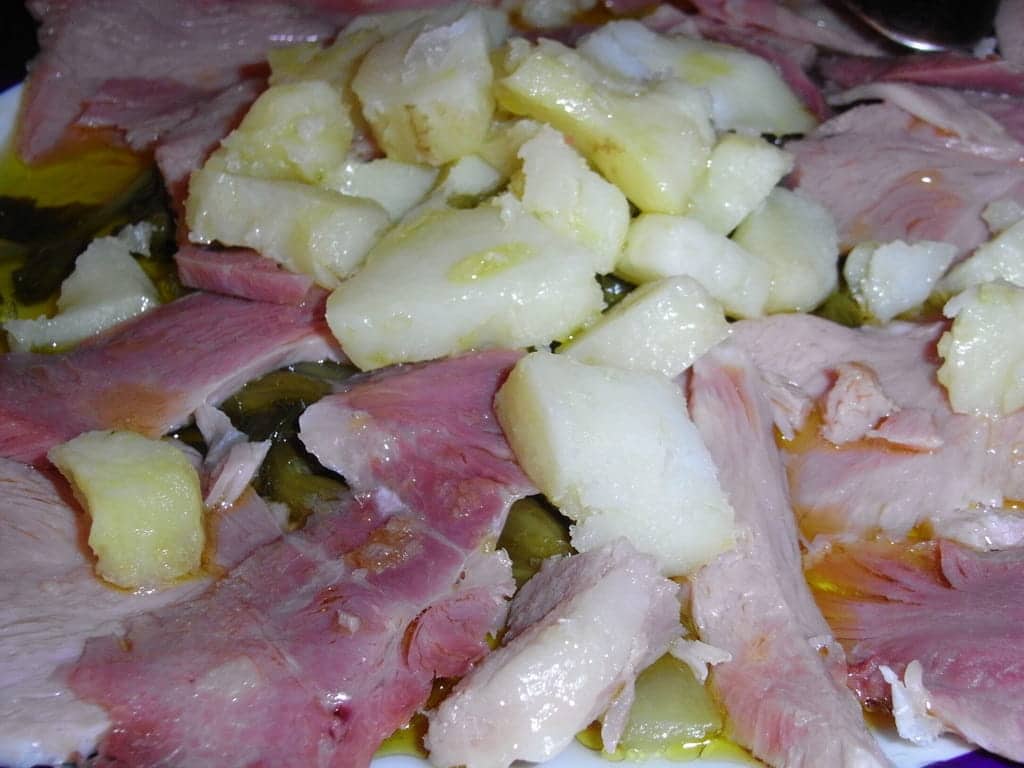
Upon entering Galicia through the mouth of the Miño River (after crossing by boat from Caminha to A Guarda), the route from A Guarda to Santiago de Compostela offers some of the finest Galician delicacies.
In the Rías Baixas, Albariño wine from the D.O. Rías Baixas reigns supreme. Specifically, in the stretch of Oia, O Rosal, and Baiona, the pilgrim walks through vineyards and can visit a winery without straying far from the route. The O Rosal subzone, near the Miño River, produces excellent wines, and in towns like Cambados (a bit further north, though off-route) the famous Festa do Albariño is held.
Without straying, you can find wine shops where you can taste these increasingly popular Galician whites. The Galician coast also offers seafood and fish with quality seals: the Ostra de Arcade (oysters from the Vigo estuary) is a traditional local product highly appreciated by both pilgrims and locals.
Another small but very spicy product that characterises the central Portuguese Camino is the Pimientos de Herbón D.O.P., better known as Padrón peppers. They are grown here and have been protected under D.O.P. since 2009. They are usually fried and served with coarse salt, and as the saying goes, “some are hot and others are not”.
In fact, at the end of July, the Fiesta del Pimiento de Herbón is celebrated in Padrón, coinciding with the time when many pilgrims pass through this stage.
Heading towards Santiago, the route passes through Caldas de Reis, an area famous for two other treasures: Lacón con grelos (salted pork shoulder with turnip greens, the grelos of which have the IGP “Grelos de Galicia”) and Galician empanada made with millo (corn), typical of Milladoiro. Although the empanada doesn’t have a designation, in many bakeries you’ll find homemade empanadas filled with scallops, tuna, or corn.
Lastly, let us not forget that the Portuguese Camino offers sweet delights such as Rosquillas de Pontevedra, with a centuries-old recipe. And to accompany, nothing better than a shot of Orujo de Galicia (grape pomace spirit) with a Geographical Indication seal. In the same town of Padrón, a famous coffee liqueur is made.
Camino Sanabrés
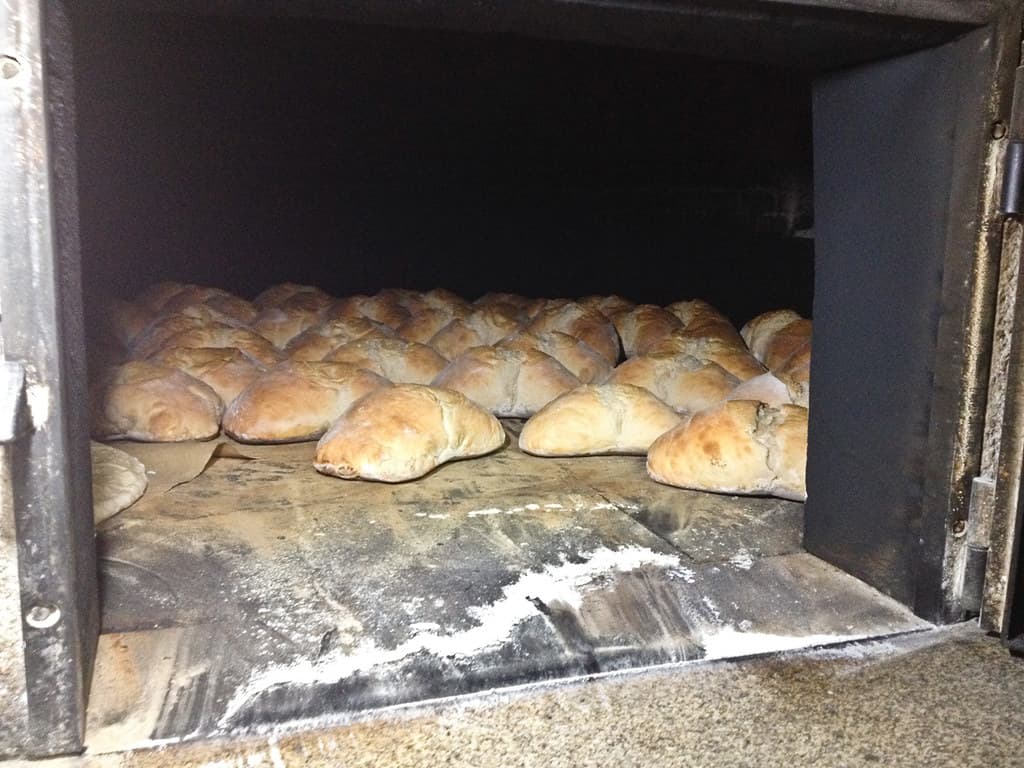
On the Camino Sanabrés, you will enter the land of D.O. Ribeiro wine (the oldest wine denomination in Galicia). The Camino passes near Ribadavia, although it requires a small detour. However, it is not necessary to take it to taste the wine, as it is served everywhere in the city of Ourense and the surrounding villages.
A little further on, the final stretch of the Sanabrés coincides with the area of D.O. Ribeira Sacra, famous for its Mencía red wines grown on vertiginous slopes. Some pilgrims opt for the winter variant that goes through the Ribeira Sacra just to admire the terraced vineyards and, in the process, taste these wines.
Another essential product on this route is Pan de Cea, with a Protected Geographical Indication. It is made in the municipality of San Cristovo de Cea, very close to the Camino Sanabrés. This wheat bread stands out for its thick crust, compact crumb, and long shelf life, making it an ideal food for pilgrims.
It is not necessary to detour to try it: in Cea, you can visit the traditional ovens where it is still baked in a wood-fired oven, and many local bakeries offer it freshly made. Additionally, in June, the Festa do Pan de Cea is held, an event that brings together local bakers and visitors around this emblematic product of Galicia.
Other routes: from Galicia to the table
Of course, all the routes of the Camino de Santiago have their characteristic products with protected designations of origin. It would be impossible to mention them all, but it is worth highlighting a few additional ones for those who choose less common routes:
- Camino Inglés: In Ferrolterra, at the start, the pilgrim can try the Torta de Ferrol (local almond cake) or pan de Neda, famous in the Ferrol estuary. In Betanzos, besides its famous potato omelette, wine from the IXP Betanzos is made, a little-known but historic Galician wine.
- Camino de Fisterra and Muxía: On this route along the Costa da Morte, the Mexillón de Galicia D.O.P. (Galician mussel) stands out, as in piers like those in Corcubión or Finisterre you can buy super-fresh mussels. Likewise, in Muxía, the Octopus and salted sardine (sardines in brine) are famous, linked to traditional local fishing.
As you can see, it is not necessary to leave the Camino to discover authentic delicacies with protected designations of origin. Each town has something to offer the pilgrim: whether it’s a wine to toast at the end of the stage, a cheese to snack on during a break, or a typical sweet to lift your spirits. These products are part of the Camino’s cultural heritage: buying them directly from their place of origin helps local economies and enriches the travelling experience.

